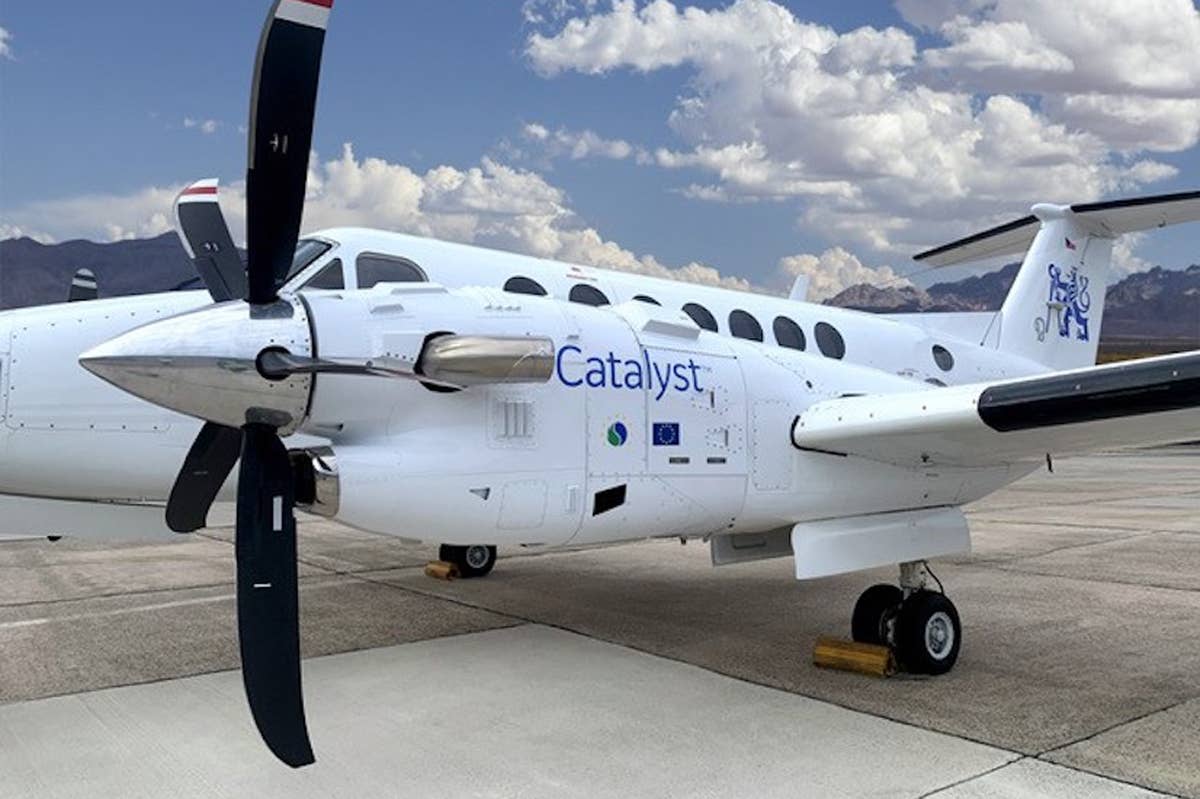
The Catalyst engine is now installed on GE’s flying test bed King Air. GE Aviation
GE Aviation’s Catalyst engine will be the company’s first, all-new clean sheet turboprop engine in 50 years, according to the company’s website. It borrows many technologies from GE’s big engine business to create a full-authority digital engine control (FADEC) turboprop that—if it lives up to expectations—is certain to give Pratt & Whitney Canada’s venerable PT6 a run for its money. Textron Aviation chose the Catalyst to power its new Denali single-engine turboprop. GE expects Catalyst to be certified before the end of 2021. A bi-lateral agreement with European authorities means the FAA and EASA will recognize each region’s work on this US-designed engine that GE expects to be certified before the end of 2022. Work on Catalyst began in 2016. The result has been an engine with 800 fewer parts than traditional turboprops, all thanks to 3D printing.
I checked in for a progress update on Catalyst with Paul Corkery, the company’s general manager for advanced turboprop engines in general aviation and integrated systems, at GE’s AirVenture booth. Corkery reminded me that—thanks to that FADEC—Catalyst is designed to maintain more horsepower and hence more speed to a higher altitude while burning significantly less fuel than its closest competitor. Catalyst at its core, is expected to be a 1,300-horsepower engine, derated to about 1,050 hp for the Denali. “We’ve had six different test cells in place in the Czech Republic around Prague,” in the middle of GE’s European engine operation, Corkery said. Why Prague? “Because we have 400-plus engineers working on this, and we went to where we had expertise in this technology. But we also have a plane (a King Air 350) in Berlin,” that has the first Catalyst strapped on ready for the flight testing to begin. “The King Air is expected to fly about 40 test hours in Germany, before moving on to the Czech Republic for the balance of the flight testing, about 100 hours in total.”
When King Air flight testing is completed, “and we get to final assembly, it’s all going to be in Prague,” he told me. “We’ll have gearboxes and things coming from Italy, we’ll have rotating equipment from different places in Europe and all that will converge with final assembly testing in our Prague facilities.” Corkery said the basic engine has already completed about 30 percent of its certification testing. “We just finished up the icing test, which is a big one. We’re also doing the testing on the initial maintenance intervals (IMI).” The Denali test aircraft in Wichita also has a flight-worthy engine already mated to the airframe just waiting for a final OK to fly.
Corkery said Catalyst, “at 31,000 feet is producing more power than we thought. I think the challenge I’ve had on this on this program is all a paperwork to get the experimental permit to fly in Europe. It’s been a journey.”
While GE hopes to find additional Catalyst customers down the road, Corkery said, “we’re laser focused on the Denali right now to support our customer’s [Textron Aviation’s] launch schedule. We have to demonstrate performance.” He believes the FADEC controlled Catalyst is unique in this marketplace because most engines are normally hydro mechanical control systems. “For one thing, FADEC makes engine management simpler for the pilot. It gives you an optimized reference for where my torque should be and where my speed should be. It sends a signal to the prop controlling the fuel controller. We’re seeing a 15-17 percent fuel burn improvement [over our competitors].”
There’s a lot of investment in Europe around sustainable fuels. “This engine will be running those over the next year,” Corkery added. “It also positions us for hybrid market, which is in its infancy here, but is starting to grow. If you take this prop off and put a permanent magnetic generator on and a power converter, you just created electrical energy for all sorts of different configurations. Another thing is the reduced fuel burn which means less CO2 and 24 percent less NOx. We also feel we’re very well positioned to go into the one-megawatt class hybrid type of solutions.”
“We feel good about this engine. It’s really setting the foundation for us in the future. Of course, my hat’s off to the competition. They’re good. My jobs, you know, is to make their lives tougher, but they’re very, very good. They’ve been around a long time. But I think we’re bringing the right technology [to the marketplace] at the right time.”

Sign-up for newsletters & special offers!
Get the latest FLYING stories & special offers delivered directly to your inbox






